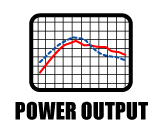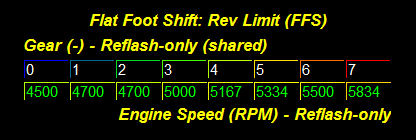Supported Vehicles:
- USDM 2015 - 2018 Volkswagen Golf R
Map Revision:
- Anti-Theft Mode v201
- Stage0 v201
- Valet Mode v201
- Stage1 v201
- Stage2 v201*
- Stage3 v201
Note: Starting with v109 Stage2 and Stage3 calibrations include increased power output over previous revisions. DSG vehicles require upgraded transmission tuning software at these stages.
Map Availability:
- Download from the COBB Tuning Volkswagen Golf R OTS Map Database.
Required Accessport Firmware:
| Warning | ||
|---|---|---|
| ||
Running a stage 2 map on a vehicle without an upgraded clutch or DSG tune may cause slipping or damage to your clutch/clutch pack. |
COBB Custom ECU Features
COBB Custom Features: Volkswagen MQB Platforms
Stock
Stage2
Stage3
Map | Peak Gains* | Largest Gain* | |||
|---|---|---|---|---|---|
| Stage1 93 | +23.93% HP / +19.7% TQ | +24.60% HP / at 6100 RPM / +24.2% TQ at 4000 RPM | |||
Stage2 93 | +32.2% HP / +36.62% TQ | +34.52% HP at 5520 / +42.85% TQ at 4100 RPM | Stage3 93 | +39.7% HP / +42.3% TQ | +43.1% HP at 5600 RPM / +49.5% TQ at 4050 RPM |
*Peak gains are measured as the difference between the highest points of the two plots.
*Largest gains are measured as the largest gain at any single point between the two plots.
Results may vary. Power as tested on 2016 Golf R Manual using these identical calibrations. Generally speaking, the 91 octane calibration has a richer fuel curve and a less aggressive ignition advance map to help compensate for 91 octane fuel and/or less than ideal atmospheric conditions. The map designed for 93 octane is the most aggressive. The MK7 is relatively sensitive to charge air temperature and as such has dedicated tables to deal with charge air increases. It is important to consider final timing when analyzing power output.
To get a better idea of how to compare charts from one dyno or car to the next, check out the links below!
Stage 1
- Intake Requirements :
- stock air filter
- Stock airbox with drop-in replacement,
- COBB SF Intake 7V2150 (Carb under D-660-30)
- COBB Redline CF Intake 7A1100 (CARB under D-660-30)
Exhaust Requirements: Stock exhaust or upgraded cat-back exhaust
Boost Target:
91 Octane 95 RON Minimum: ~21 psi peak boost pressure tapering down to 16~ psi as you approach the 6800RPM redline, +/- ~1.5psi.
- 93 Octane 98 RON Minimum: ~22 psi peak boost pressure tapering down to ~16psi as you approach the 6800RPM redline, +/- ~1.5psi.
| Panel | ||
|---|---|---|
| ||
Stage 2
C.A.R.B Note The above Stage2 calibration is legal for use on Emissions Controlled Vehicles in all 50 states when used in accordance with the manufacturer's application guide because it and the parts have a California Air Resources Board (CARB) Executive Order (EO) number: d-660-34 |
Stage 3 Maps
- stock air filter
- Stock airbox with drop-in replacement,
- COBB SF Intake 7V2150 (Carb under D-660-30)
- COBB Redline CF Intake 7A1100 (CARB under D-660-30)
Exhaust Requirements: COBB Tuning Catted Downpipe with 3" Cat-back Exhaust
Boost Target:
91 Octane 95 RON Minimum:~27 psi peak boost pressure tapering down to ~20 psi as you approach the 6800RPM redline, +/- ~1.5psi.
Non-Performance Maps
Anti-Theft Mode
Will not allow vehicle to start
Valet
Fuel Requirements: 91 octane or better
Intake Requirements: Stock airbox and stock air filter
Exhaust Requirements: Stock exhaust
Boost Targets: Mechanical minimum
Rev Limiter: 3000RPM
*Not intended for aggressive driving*
High Altitude:
A quick note for those of you that live at higher altitudes: it is common for turbocharged cars at higher altitudes to run less boost pressure due to lower air pressure and air density. Your turbocharger has to work harder to compress a less dense air mass compared to the same turbocharger at sea level. This must be factored in when determining if your turbocharger is running the proper amount of boost pressure and not being pushed beyond its efficiency range.
Example: If you live in Denver at 5280 ft. and are trying to run a peak boost pressure of 15 psi, your turbocharger has to work the equivalent of making ~17.5 psi at sea level.
There are barometric compensations within the factory ECU that lower boost targets as you climb in altitude in an effort to keep the turbocharger in its optimal range. The COBB performance maps utilize these compensations and therefore, it is perfectly normal for the final boost / load value to be lower than what is listed for your map.
Revision Notes:
| Note |
|---|
OTS maps with LC, FFS and TC adjustments available on the Accessport: The values in the adjustments menu on the AP are temporary and will not persist after an extended key off time (apporx. 5-30 minutes). This is normal and the default values will be loaded the next time the feature is used. |
v201
No calibration changes.
- This map has been updated to our Green Speed standard to ensure compliance with EPA and CARB regulations. This map eliminates unnecessary DTC suppression to ensure full environmental compliance.
v200
Consolidation of OEM ROMs into C0BB01.
v110
Made changes to traction control settings see: COBB Custom Features: COBB Traction Control on MK7 Vehicles
v109
- Corrections to spelling
v108 (DSG) (2015-2017) –
- Corrected an issue in 2017 Golf R maps related to LC and FFS rev limits persisting during normal driving conditions. 2015 and 2016 Golf R maps updated for version parity. Custom maps need to be opened and re-saved in Accesstuner Pro HL version 2.0.0.0-15791 or newer.
- Removed model year from vehicle application name.
v107 (MT) (2015-2017) –
- Corrected an issue in 2017 Golf R maps related to LC and FFS rev limits persisting during normal driving conditions. 2015 and 2016 Golf R maps updated for version parity. Custom maps need to be opened and re-saved in Accesstuner Pro HL version 2.0.0.0-15791 or newer.
- Removed model year from vehicle application name.
v106 (DSG) (2015-2017) –
- Enabled Cobb Custom Features: Launch control and Flat Foot Shift. More details here - COBB Custom Features: Volkswagen MK7 Launch Control, Burnout Mode, and Flat Foot Shifting
- Flat Foot Shift RPM (Per Gear):
- Burn out mode Rev. Limit: 5000 RPM
- Launch Control Rev. Limit by speed/slot:
- Flat Foot Shift RPM (Per Gear):
v105 (MT) (2016-2017 MT) –
- Enabled Cobb Custom Features: Launch control and Flat Foot Shift. More details here - COBB Custom Features: Volkswagen MK7 Launch Control, Burnout Mode, and Flat Foot Shifting
v104 (DSG) (2017) –
- Corrected an issue causing the factory launch control to not engage on 2017 Golf R DSG vehicles has been identified and solved. 2017 Golf R OTS maps have been up-revved to address this issue, 2015-2016 Golf R maps are not affected. Custom maps need to be opened and re-saved in Accesstuner Pro HL version 2.0.0.0-15553 or newer.
- These calibrations have enabled Stage2 and Stage3 power for DSG vehicles with upgraded transmission software.
Note: v104 calibrations are available via download from the COBB Website only.
- All other applications were updated for version parity (No calibration changes)
v103 (2017) –
- Corrected an issue causing the factory launch control to not engage on 2017 Golf R DSG vehicles has been identified and solved. 2017 Golf R OTS maps have been up-revved to address this issue, 2015-2016 Golf R maps are not affected. Custom maps need to be opened and re-saved in Accesstuner Pro HL version 2.0.0.0-15553 or newer.
- All other applications were updated for version parity (No calibration changes)
v102 (DSG) (2015-2016) –
- These calibrations have enabled Stage2 and Stage3 power for DSG vehicles with upgraded transmission software.
Note: v102 calibrations are available via download from the COBB Website only.
v101 (2015-2016) –
- Initial release, revised ignition timing, primary fueling and boost levels for performance and safety.



